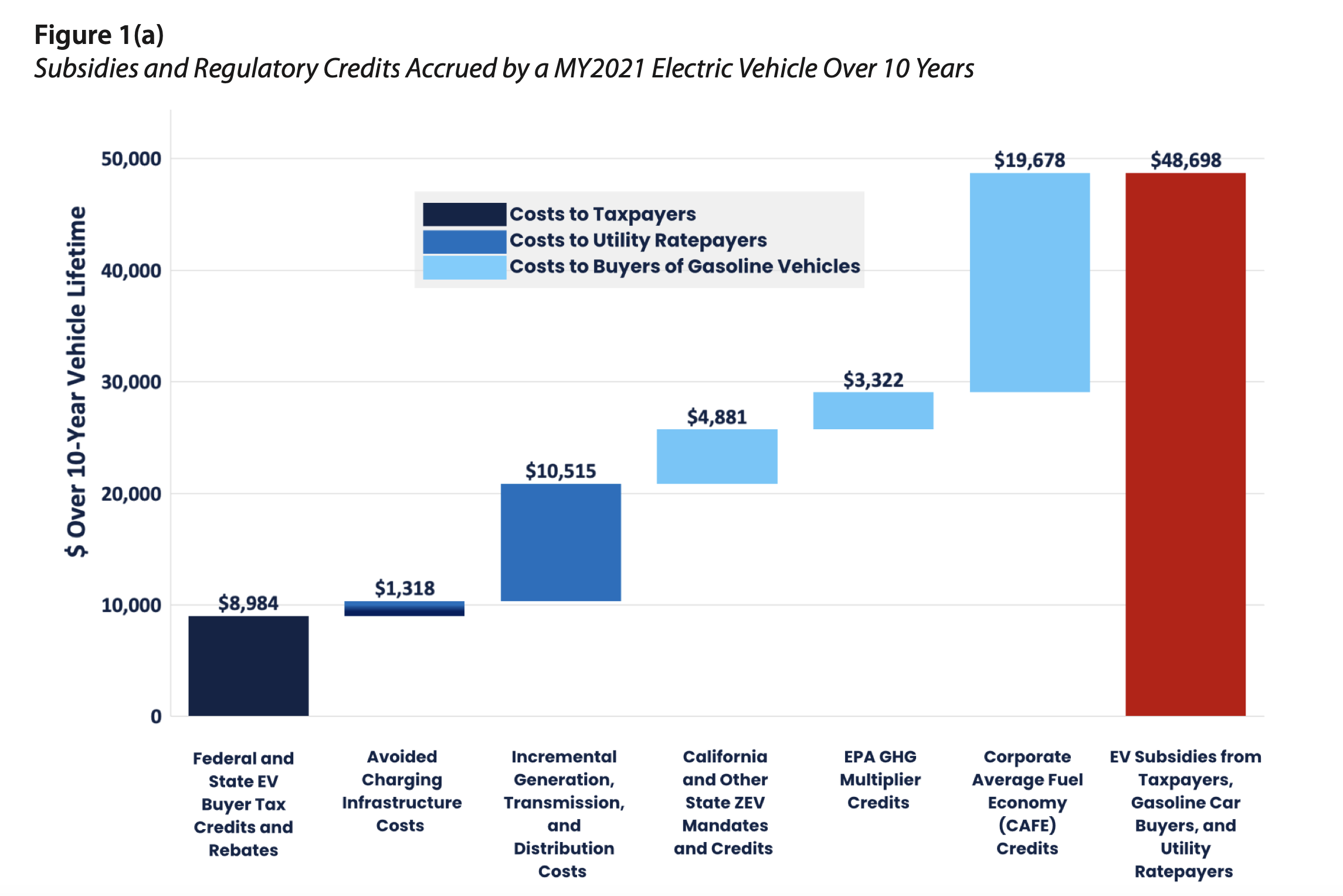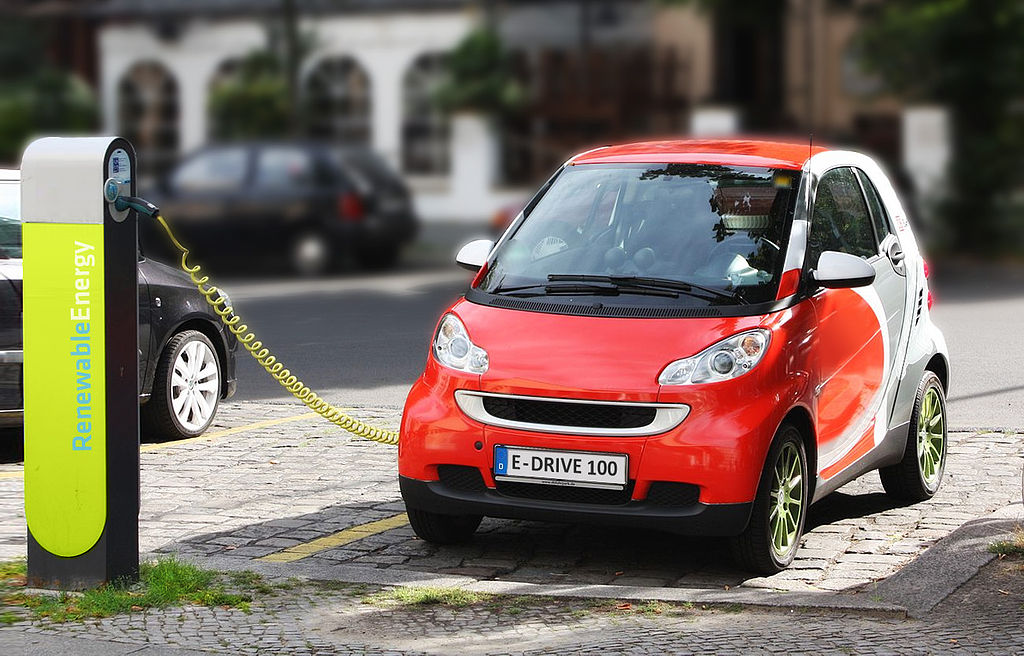
An electric car charging on the street. (Photo: Shutterstock/guteksk7)
Texas Public Policy Foundation Unmasks the True Costs of Electric Vehicles
EVs would cost nearly $50K more to own over 10 years without $22 billion in government subsidies
By Katy Grimes, October 30, 2023 2:18 pm
With news reports showing Electric Vehicles stockpiling in car lots, unsold, all across the country, it’s curious that California Governor Gavin Newsom just announced the state surpassed its zero-emission vehicle (ZEV) truck sales goal two years ahead of schedule. And how did California accomplish this? According to the governor, “California has distributed more than $780 million to help fleet operators purchase ZEV trucks.”
Newsom and the state’s environmental lobby are pushing to phase out all internal combustion trucks and big rigs, as they claim that trucks account for over a quarter of the state’s on-road greenhouse gas emissions.
But, people don’t want what Gov. Newsom is selling – not electric trucks or electric vehicles.
And notably, the Ford Motor Company is losing over $70,000 on each EV it currently sells. Three-decade energy sector reporter Robert Bryce, reported in July, “Ford reported a $1.08 billion operating loss on its EV business during the second quarter. During that span, Ford sold 14,843 EVs. That means Ford lost about $72,762 for each EV it sold. That’s an even bigger loss than what the company saw during the first quarter and they portend even bigger losses ahead. Ford lost $2.1 billion in its EV business in 2022.
Just a few days ago, Bryce reported, “The bloodbath in Ford Motor Company’s EV division continues. On Thursday, Ford reported an operating loss of $1.3 billion in its EV division during the third quarter. That translates into a loss of $62,016 for each of the 20,962 EVs it sold during the period.”
“In its October 26 press release, Ford provided an additional comment on the EV losses, saying, ‘According to the company, many North America customers interested in buying EVs are unwilling to pay premiums for them over gas or hybrid vehicles, sharply compressing EV prices and profitability.’”
The Texas Public Policy Foundation just did all of the math in a new report, to find out if EVs are actually cost effective, and Ouch. “The average model year 2021 Electric Vehicle (EV) would cost $48,698 more to own over a 10-year period without $22 billion in government favors given to EV manufacturers and owners.” – which means we are still paying for these cars and trucks.

“Setting aside some of the questionable assumptions used in deriving such favorable economics for EVs, no one has attempted to calculate the full financial benefit of the wide array of direct subsidies, regulatory credits, and subsidized infrastructure that contribute to the economic viability of EVs.”
“EV advocates claim that the cost of electricity for EV owners is equal to $1.21 per gallon of gasoline (Edison Electric Institute, 2021), but the cost of charging equipment and charging losses, averaged out over 10 years and 120,000 miles, is $1.38 per gallon equivalent on top of that. Adding the costs of the subsidies to the true cost of fueling an EV would equate to an EV owner paying $17.33 per gallon of gasoline.”
When we pay for a gallon of gasoline, we are paying for the entire infrastructure to refine, transport, and market that gasoline. When an EV owner connects to the electric grid, how much are they paying for the extra generation, transmission, and distribution costs that they are imposing on the grid, and will those embedded costs rise over time? And then there are the federal and state taxes imposed on every gallon of gasoline compared with tax rebates for EVs, as well as the indirect subsidies created by the federal Corporate Average Fuel Economy (CAFE) standards and the Environmental Protection Agency’s (EPA) greenhouse gas (GHG) emissions standards, which this paper will show are surprisingly large and are being absorbed by buyers of ICEVs.
First are the direct subsidies paid out by the fed- eral government and many state governments.
Second are the indirect subsidies, most notably avoided state and federal fuel taxes.
Regulatory mandates make up the largest chunk of the hidden cost of EVs.
The TPPF notes, “The largest contribution is due to the CAFE standards, which in recent years have been made increasingly stringent in order to make ICEVs more expensive and to drive EV adoption. On top of that, the EPA has been empowered to enact GHG emissions standards above and beyond the de facto reductions in GHG emissions created by the CAFE standards. Many states, most notably California, also have zero emissions vehicle (ZEV) mandates that require automakers to sell a certain number of EVs in those states and act as another tax on ICEVs.”
The TPPF warns that it’s time for federal and state governments to stop driving the American auto industry off an economic cliff and allow markets to drive further improvements in cost and efficiency.








A number of stories out there now, including this one, seem to be finally coming out and making an impact in rather dramatic ways to show that the whole GREEN push (expanding EVs and renewables etc) is not what it pretends to be and does not do what it pretends to do or cost what they pretended it would cost. It is (ironically) not “sustainable” not practical, not affordable, and it is collapsing. And by the way, it was anything but “green” in the first place. Can we end this charade now, please?
Indeed, and just as the Clunker and Junker subsidies ran out of money, older autos and trucks stopped being retired from the roads…
They have not begun to tax people yet, they want to get more on the road, and even CNN reports we will need to double the capacity of the grid to accommodate this.
Meanwhile Senor Biden has only three new electrical lines being constructed to California, I wander if this is from the coal plants or the Nuclear plants?
I don’t like paying for other people’s student loans or their electric cars. It seems the EV cost is much higher for all of us than green scammers would have us believe with their cherry picked statistics.